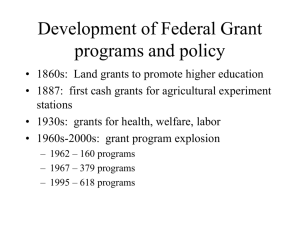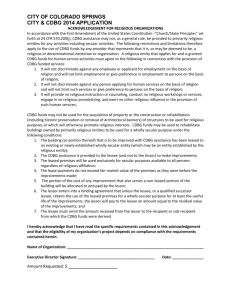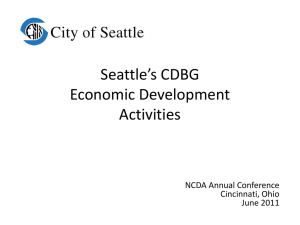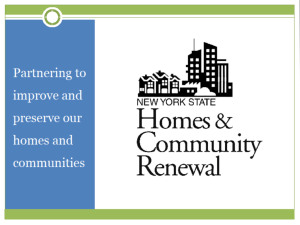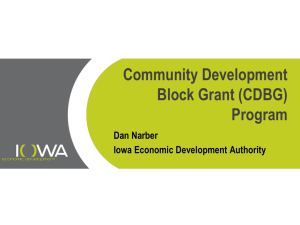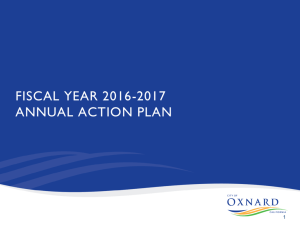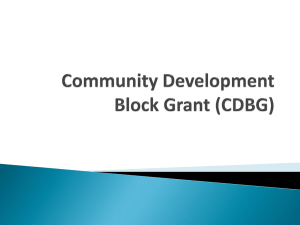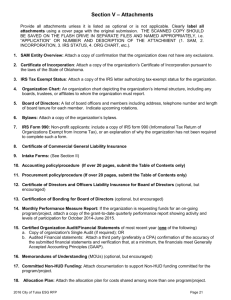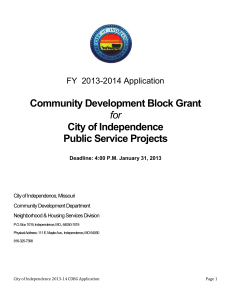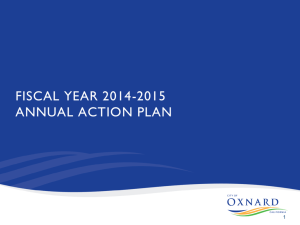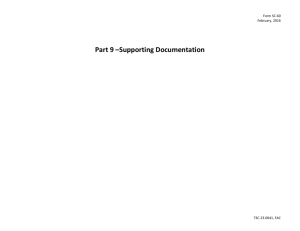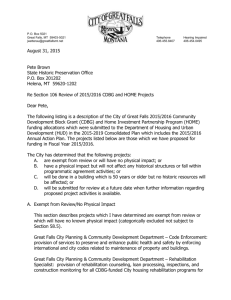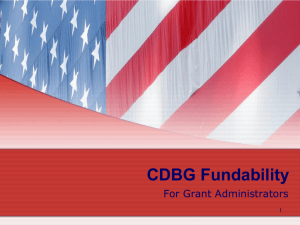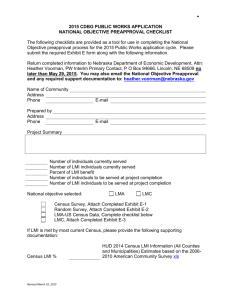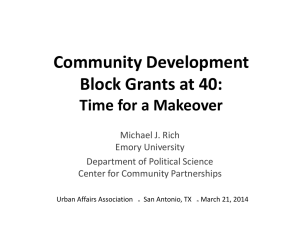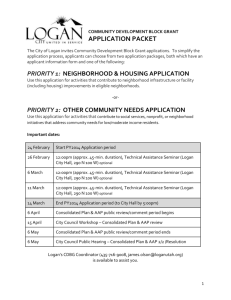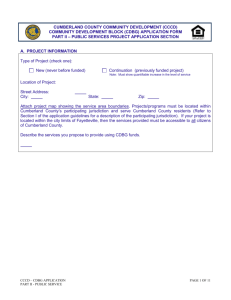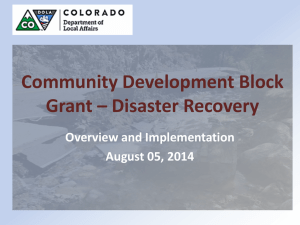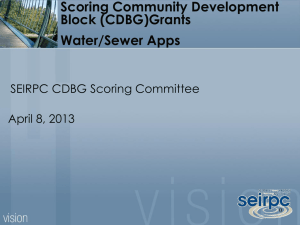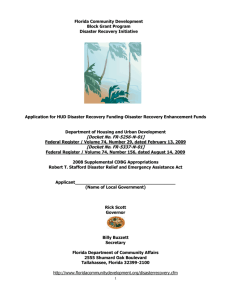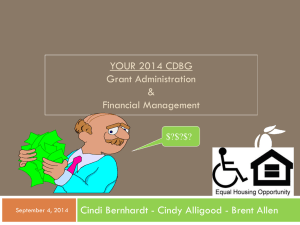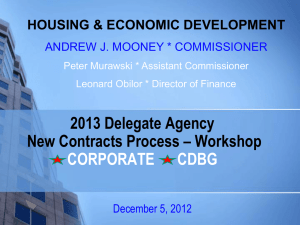Economic Development 101 - National Community Development
advertisement
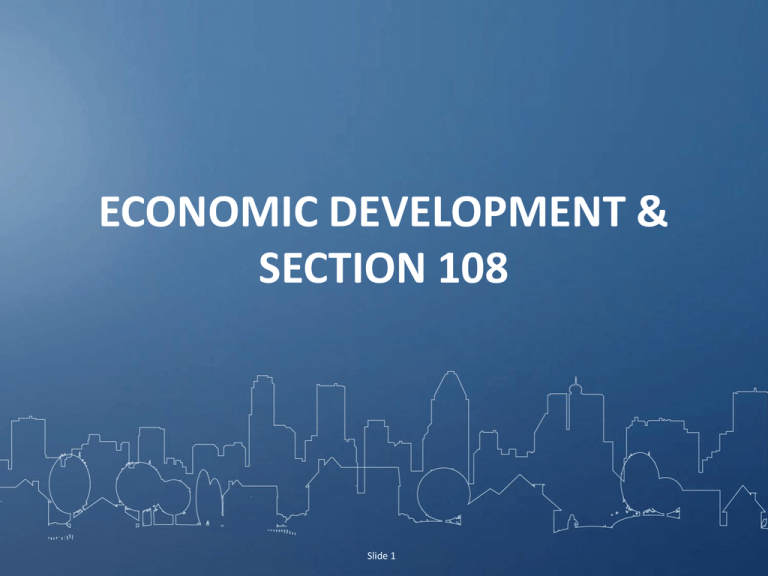
ECONOMIC DEVELOPMENT & SECTION 108 Slide 1 ELIGIBLE ECONOMIC DEVELOPMENT ACTIVITIES • Special economic development activities • Community-based development organizations • Technical assistance to businesses • Microenterprise activities • Commercial rehabilitation • Infrastructure to assist businesses • Job training Slide 2 NCDA 2013 Winter Conference CDBG ECONOMIC DEVELOPMENT 101 SPECIAL ECONOMIC DEVELOPMENT ACTIVITIES • Acquire, construct, rehabilitate, reconstruct or install commercial/industrial buildings or equipment – By recipient or subrecipient only • Assistance to for-profit businesses • Economic development services in connection with special economic development activities Slide 4 SPECIAL ECONOMIC DEVELOPMENT (cont) • Special economic development has flexibility in types of assistance to businesses – – – – Grants Loans Guarantees Technical assistance & support services • May meet several different national objectives; depends on business & location • Triggers the requirement for public benefit standards Slide 5 COMMUNITY BASED DEVELOPMENT ORGANIZATIONS • CBDOs may carry out three kinds of projects: – Community economic development – Neighborhood revitalization – Energy conservation • If job training done through a CBDO, doesn’t count against public services cap • CBDO economic development activities do trigger public benefit standards Slide 6 TECHNICAL ASSISTANCE TO BUSINESSES • Helps reduce risk of business failure • Often focused on business plan development or legal and accounting issues • Often offered in conjunction with financial assistance • Critical to programs directed to start-ups • DUNS # not required for TA Slide 7 TECHNICAL ASSISTANCE TO BUSINESSES (cont) • Under CDBG: – As part of special economic development • Caveat: must meet public benefit – As a micro enterprise assistance task – As a public service – Through a CBDO • Must also meet public benefit Slide 8 MICROENTERPRISE ASSISTANCE • CDBG can fund micro enterprise assistance • Micro enterprise defined as: – Owners or persons who work toward developing, expanding or stabilizing a business – Commercial enterprise with employees (including owner) • Note: This definition differs from SBA Slide 9 MICROENTERPRISE ASSISTANCE (cont) • May provide assistance as loans, grants and other forms of financial support • Other support activities eligible: – TA, advice, and business services to owners and persons developing microenterprises – General support to owner and persons developing microenterprises – Training and TA to build recipient and subrecipient capacity Slide 10 MICROENTERPRISE ASSISTANCE (cont) • Can do TA and training to increase capacity of recipient/subrecipient to do microenterprise programs • No limit on amount or type of CDBG loan/grant to each microenterprise • Not subject to public benefit test if separate program under §570.201(o) • Owner not required to be LMI, but must meet a national objective Slide 11 COMMERCIAL REHABILITATION • Rehabilitation of commercial or industrial structures – §570.202(a)(3) • If private, for-profit owner: – Rehabilitation limited to exterior of building and correction of code violations – Other improvements must be carried out under the special economic development category §570.203 • Not subject to public benefit standards if carried out under §570.202(a)(3) Slide 12 INFRASTRUCTURE FOR ECONOMIC DEVELOPMENT • Roads, streets, sewers that are: – Leading to business location – Within an industrial park – On a business site • If public facility must be owned by public agency/nonprofit • If owned by business, conduct as special economic development • Triggers the public benefit standard if using the jobs national objective standard and spend more than $10,000/job Slide 13 JOB TRAINING • Help unemployed or under-employed persons gain skills to meet labor market demands • Linked to job placement • Job training is eligible: – As a public service -- §570.201(e) – As part of special economic development project -- §570.203 (c) – As part of microenterprise activities -- §570.201(o) Slide 14 INELIGIBLE ACTIVITIES • Job pirating is prohibited – If assist in relocation of plant, facility or operation AND – Relocation will result in significant loss of jobs in another geographic area of U.S. • Significant loss defined as: – Number of lost jobs is equal or greater than 1/10th of 1% of jobs in labor market area OR – Loss of 500 jobs Slide 15 ECONOMIC DEVELOPMENT NATIONAL OBJECTIVES • Economic development projects typically fall under Low/Mod Job Creation/Retention • Be sure to document: – – How jobs will be created or jobs will be lost without CDBG (retained jobs) How jobs made available to or held by LMI • Track jobs for reasonable period of time (not defined in regulations) as long as jobs are still being created Slide 16 JOB CREATION NATIONAL OBJECTIVE • May presume person is LMI if: – – – – Lives in Census tract with 70% LMI Lives in Census tract within EZ/EC Lives in Census tract area with poverty rate of 20% and no CBD (unless 30% poverty) and evidences pervasive poverty and general distress Business/job is located in EC/EZ; OR area with poverty rate of 20% and no CBD (unless 30% poverty) and evidences pervasive poverty and general distress Slide 17 OTHER NATIONAL OBJECTIVES • Some activities may qualify under other Low/Mod national objective categories – Micro enterprises: limited clientele – Job training: limited clientele – Service type businesses: area benefit • Some economic development activities may meet Slum/Blight Area national objective – – Activities must be in a designated Slum/Blight Area or rehab under Spot Slum/Blight Activities must address conditions of deterioration Slide 18 EVALUATING ECONOMIC DEVELOPMENT PROJECTS • Evaluation and selection of economic development projects has two parts: – Voluntary underwriting guidelines – Mandatory public benefit standards • Determinations must be in writing (§570.200(e)) Slide 19 VOLUNTARY UNDERWRITING GUIDELINES • Grantees should ensure that: 1. 2. 3. 4. 5. 6. Project costs reasonable All sources of financing are committed CDBG not substituted for non-federal Project is financially feasible Return on investment reasonable CDBG funds distributed pro-rata Slide 20 PUBLIC BENEFIT STANDARDS • Mandatory for the following activities: – Special economic development projects -- §570.203 – CBDO projects, as applicable -- §570.204, and – Public improvement projects classified under Low/Mod Job Creation/Retention where more than $10,000/job in CDBG assistance • Not applicable to microenterprise activities (§570.201(o)) or commercial rehabilitation – (§570.202(a)(3)) Slide 21 CALCULATING PUBLIC BENEFIT • Two options for determining benefit: – – Jobs created or retained Goods or services provided to LMI persons • Projects must meet individual test • Entire program must meet aggregate test • Applied at time of CDBG obligation & assessed upon completion based on actual achievements Slide 22 INDIVIDUAL STANDARDS • May not exceed $50,000 per FTE permanent job created or retained OR • May not exceed $1,000 in expenditure per LMI person to which goods or services are provided Slide 23 APPLYING THE INDIVIDUAL STANDARDS • Standards apply to all activities obligated in any given CDBG program year • One or the other standard must be met – Job creation/retention OR – LMI goods or services • Use jobs created/retained standard when assisting a job-training-only activity Slide 24 AGGREGATE STANDARDS • Create or retain at least one full-time-equivalent (FTE) permanent job per $35,000 of CDBG funds OR • Provide goods and/or services to at least one LMI person per $350 of CDBG funds Slide 25 APPLYING THE AGGREGATE STANDARDS • Standards apply to all activities obligated in any given CDBG program year • One or the other standard must be met – Job creation/retention OR – LMI goods or services • Use jobs created/retained standard when assisting a job-training-only activity Slide 26 WHAT IS SECTION 108? • Financing arm of the CDBG program • Debt, not grant funding • Loans backed by full faith and credit of the US Government for – Job creation – Public Facilities – Affordable Housing Slide 27 ADVANTAGES OF SECTION 108 • Leverages grants • Not a general obligation • Receive funds now (no pay as you go) • Spread costs over multi-year period • Long-term, fixed-rate financing at favorable rates Slide 28 LENDING FEATURES • Low-priced long-term debt: up to 20yrs • Flexibility of terms – Possibility of interest only payments – Flexible amortization schedule – Negotiable collateral/subordination arrangements • Low interest rates / lower cost debt – pegged rates to 3 month LIBOR and – 10 year Treasury note averages Slide 29 ELIGIBLE ACTIVITIES • • • • • • • • • • • Real property acquisition Rehabilitation of publicly owned real property Relocation Clearance/demolition Site preparation Housing rehabilitation Economic development Public facilities/improvements Issuance costs Capitalized interest Reserves Slide 30 APPLICABLE RULES • Section 108 must comply with all key CDBG rules – – – – Eligible Activity Meet a National objective 70% LMI-benefit targeting Other federal requirements • • • • • • • Environmental review Davis Bacon URA OMB circulars Fair housing/equal opportunity Lead Based Paint HUD Reform Act Slide 31 SECTION 108 FINANCING HUD Guarantee Interim Lender Guarantee Guarantee Pledge of CDBG Funds Investors Perm. Fin. Loan Proceeds [State] Loan Proceeds Slide 32 Locality Link to Basically CDBG Presentation • https://www.onecpd.info/resources/documen ts/BasicallyCDBG_Slides.pdf Slide 33
